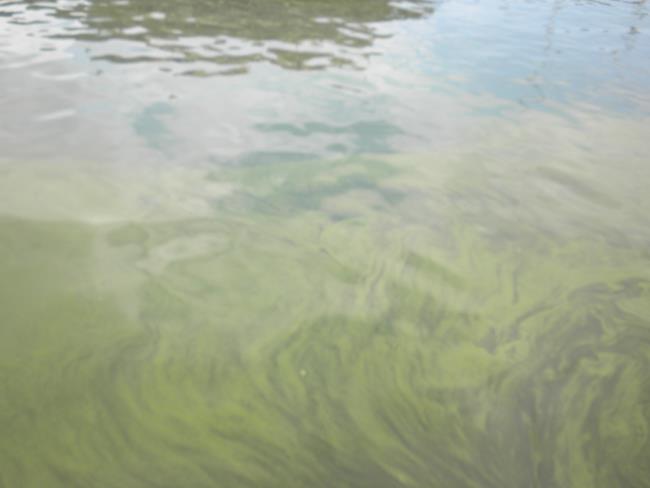Buffalo, NY, December 15, 2011 - Back in the 1970’s, Lake Erie was called a "dead lake" because of pollution that resulted in little or no oxygen in a large part of the lake.
Today, the lake's health is once again threatened from a number of sources. Ray Marks, a contributor to Buffalo's NPR News Station WBFO 88.7 FM, takes a look at the factors contributing to the Lake's declining health:
Last spring's heavy rains resulted in runoff from farms and other sources, loading Lake Erie with nutrients containing phosphorus, which produces algal blooms that look like bright green soup. The algae can cause skin irritation to humans and animals exposed to it.
Helen Domske is a Coastal Education Specialist with New York Sea Grant at the University of Buffalo. "There are different types of algae. There are algae that are very beneficial and that we need, and then there are what we call these harmful algae. And the bloom that you see is actually made up of species of algae that we don't really want to see in the Great Lakes. One of those is Microcystis, which has a toxin Microcystin."
That toxin, described as green slime, could turn deadly. For example, if a dog were to go into Lake Erie and become coated with the toxin, then lick it off, the dog could become fatally ill. Even in some situations, cattle have died from the toxin.
Scientists are recommending that the methods of fertilizer application by farmers be better managed to control the pollution.
 As seen in this September 2011 picture above, it's pretty easy to spot the harmful algal blooms (HABs) - abundant or excessive growth of algae - that plague Lake Erie's waters in the summer months. Most HABs are caused by planktonic bacteria, which are suspended in the water and rely on currents to move them. Near Ohio's South Bass Island, you'll find Microcystis blooms, which have been at peak levels this past summer. For more, see the related article, "Going to the Source," from Ohio Sea Grant's Spring/Summer 2011 issue of Twineline (click here). Photo by Paul C. Focazio, NYSG
As seen in this September 2011 picture above, it's pretty easy to spot the harmful algal blooms (HABs) - abundant or excessive growth of algae - that plague Lake Erie's waters in the summer months. Most HABs are caused by planktonic bacteria, which are suspended in the water and rely on currents to move them. Near Ohio's South Bass Island, you'll find Microcystis blooms, which have been at peak levels this past summer. For more, see the related article, "Going to the Source," from Ohio Sea Grant's Spring/Summer 2011 issue of Twineline (click here). Photo by Paul C. Focazio, NYSG
Another form of pollution causing serious problems is the discarding of prescription drugs in toilets. Even the anti-depression drug Prozac has been found in blood samples taken in fish in Lake Erie. Domske says there are safer ways to dispose of the drugs. "When people no longer need medications - whether they are expired, unwanted, or don't have to be administered anymore - the first step that people used to take is to flush them down the toilet. Rather than flushing it, people can mix it with something that's unattractive to pets or people, like used coffee grinds or kitty litter, put it in a plastic bag, tape it up and then place it in a non-recyclable plastic container and throw it out in the trash."
"Something as microscopic as a Prozac tablet put in a toilet, then flushed would effect a fish. So, an awareness needs to be created amongst those who are not fishermen," says Jim Handly, who has been a charterboat captain on Lake Erie for more than 30 years. Handly says the fishery here is worth protecting. "Lake Erie is a world-class fishery and hopefully they will maintain that. Now, you mention that it hasn't been this bad since the '70s. I grew up on Lake Erie in the '50s and '60s and saw what a disaster it was. It was just a cesspool. The water was brown, it smelled, eutrophication was so bad that vegetation washed up on the beach and formed its own crust on the sand." But Handly notes that Lake Erie can recover from the pollution, and now the focus is on those algae blooms.
World-renowned scientist and expert on the world's water issues, Maud Barlow was in Buffalo recently. She urges immediate action to protect our lake waters, or the future could be very grim. "There's a new study on groundwater that shows that we've doubled the amount of groundwater that's being pumped by these wells around the world in the last 40 years. But, we're exponentially increasing that. And this study said that if the Great Lakes are being pumped as fast as the rest of world's water, they could be bone dry in about 80 years."
Demands for drinking water across the globe are growing at a staggering rate. Barlow notes that demand could out-pace supply by 40 percent by the year 2030. "Millions of more people are going to die and millions of more kids are going to be at risk. Dirty water or lack of clean water and access to clean water is already the largest killer of small children in the world, larger than HIV/AIDS, war and accidents put together ... It's [an issue that's] totally preventable."
More startling, Barlow refers to the dumping of sewage and toxins into the world's water systems every year impacts the equivalent of all humanity. Pollution and overextraction of the precious water supply is harming our bodies of fresh water. What happens to Lake Erie, the shallowest of the Great Lakes, is a sign of what can happen to the rest of the Great Lakes basin.